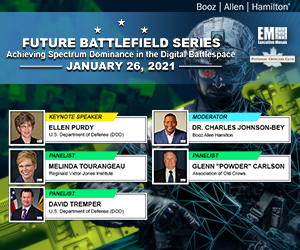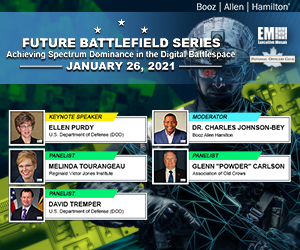With great power competition, information superiority is critical to success on the Digital Battlespace. During Potomac Officers Club’s Achieving Spectrum Dominance in the Digital Battlespace Virtual Event, notable leaders across the government contracting landscape will join together to discuss the challenges of the electromagnetic spectrum.
To register for the Achieving Spectrum Dominance in the Digital Battlespace Virtual Event, as well as view upcoming opportunities, visit Potomac Officers Club’s Event Page.
The event will feature Ellen Purdy, director of Emerging Capabilities, Prototyping Initiatives and Analysis with the Department of Defense and an expert panel, moderated by Dr. Charles Johnson-Bey, senior vice president with Booz Allen Hamilton.
The panel will host David Tremper of the Department of Defense, Melinda Tourangeau of the Reginald Victor Jones Institute and Glenn “Powder” Carlson of the Association of Old Crows.
As the future of warfare becomes increasingly reliant on information and digital tactics, our adversaries are employing information warfare to achieve overmatch, even before the physical war begins.
The battle for electromagnetic spectrum superiority has been ongoing for more than a century. China, one of the nation’s largest adversaries, has worked to strengthen its electromagnetic spectrum-enabled capabilities, increasing its threat to the U.S.
The military has leveraged radars and other sensors to locate each other and the enemy, wireless computer networks to order supplies and coordinate operations, and jammers to degrade enemy radars or disrupt communications that are critical for effective command and control.
The spectrum unites these networks. In the DOD’s Electromagnetic Spectrum Superiority Strategy, the spectrum is identified as an enabler of military operations in other domains. The Department has also advocated for the deeper integration of computer networks into electronic warfare, with such capabilities to be used alongside precision kinetic strikes.
Because of the low-cost of entry into spectrum use, alongside common use of wireless communications equipment, any adversary has as much access to the spectrum as the DOD. Adversaries have also leveraged jamming techniques to block DOD from using portions of the spectrum.
“Technologies evolved and our peer competitors have improved and watched us over the years and have gotten smart,” Frederick Moorefield, the deputy chief information officer for command, control and communications said. “We’re getting jammed on everything from GPS to our [unmanned aircraft systems.] That is a contested environment.”
The congested spectrum environment is due to the increase of users, both stateside and abroad, across warfare and training. “The spectrum space is getting more and more crowded,” Moorefield said. “That includes 5G, the next G coming, SATCOM, tactical radios, commercial and federal.”
DOD recently announced that it will work to prevent interference to aviation instruments, as the Federal Communications Commission (FCC) continues to auction C-band spectrum used for 5G communication.
“The approach should be not on trying to slow down 5G metro deployment, but speeding up development and testing of mitigations that can serve as an interim gap until avionics manufacturers can harden their systems,” said Alan Burke, the Pentagon’s chair for the interagency Aviation Cyber Initiative Task Force.
Additionally, to increase power and deployment, DOD has awarded a $2.5 billion in Other Transaction Agreement (OTA) to a consortium of nearly 400 companies and academic institutions to prototype dual-use technologies that use the electromagnetic spectrum.
The National Spectrum Consortium (NSC) will have five years to disburse the money to its members. The goal is to promote novel uses of 5G telecommunications technology, including internet of things management, cloud computing, augmented reality and big-data processing tools. The contract is called the Spectrum Forward OTA.
“An Other Transaction Agreement is the most effective method to encourage rapid prototyping in the US Government,” Tony Melita, executive director of the National Spectrum Consortium, said in the release. “By bringing industry, academia and the government together, the NSC will tackle the toughest spectrum-related technological challenges facing our nation and the world.”


Join Potomac Officers Club for its Achieving Spectrum Dominance in the Digital Battlespace Virtual Event to discuss the challenges of the electromagnetic spectrum, including spectrum competition in a contested and congested environment, and how enablers such as partnerships and technological innovation can overcome these hurdles and increase the speed of understanding, analyzing, and acting on an explosion of data on the Digital Battlespace.
To register for the Achieving Spectrum Dominance in the Digital Battlespace Virtual Event, as well as view upcoming opportunities, visit Potomac Officers Club’s Event Page.







